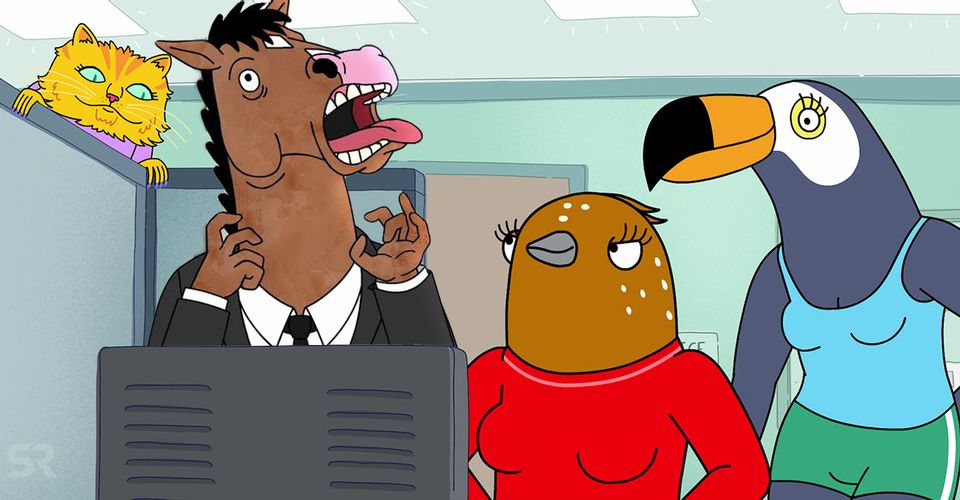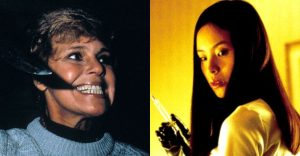How Tuca & Bertie Compares To BoJack Horseman (It’s Much More Surreal)

Netflix’s new animated comedy Tuca & Bertie comes to us courtesy of BoJack Horseman’s producer, but how do the two shows compare? When BoJack Horseman premiered on Netflix in 2014, the streaming service’s time as a provider of original content was still pretty new and the animated Hollywood satire about a washed up anthropomorphic horse was only warmly received. Cut to five years later and Netflix are kings of television and BoJack Horseman has become celebrated as one of the sharpest, bleakest and bravest dark comedies on the air right now.
One of the most unique selling points of BoJack Horseman is its visual style, blending childlike simplicity with goofy surrealism. The anthropomorphic animals come courtesy of illustrator Lisa Hanawalt, the award-winning cartoonist and long-time friend of the show’s creator, Raphael Bob-Waksberg. Now, she’s branching out with her own series, Tuca & Bertie.
In discussing her vision for the series with The Los Angeles Times, Halawalt emphasized that she had “zero interest in creating ‘BoJack 2’,” preferring to make things “a little a grosser, more surreal, more bodily humor […] I want to get into that dark stuff because that’s part of growing up as well.” The first season of Tuca & Bertie sets up the world of its eponymous duo, two 30-year-old best friends who are trying to navigate the pitfalls of adulthood and the more abrasive parts of their own relationship. After moving in with her sweet boyfriend (voiced by Steven Yeun), anxious song thrush Bertie (voiced by Ali Wong) feels torn between her neuroses which crave safety and her desire to do something less ordinary with her life. Her best friend Tuca (voiced by Tiffany Haddish) is a more care-free woman with no job, no responsibilities, and no idea how long she can keep up such a lifestyle for.
It’s easy to glibly dismiss the show as just another version of BoJack Horseman, or the latest in a steady stream of raunchy animated comedies aimed at adults, but that would be doing a major disservice to Tuca & Bertie, a show that proudly stands on its own two feet. Of course, Netflix have only been all too happy to lean into the comparisons for the series’ marketing and the matching visuals have led some to wonder if there will ever be a cross-over. By design, comparisons are inevitable, but there is also much to gleam from such things, particularly in the ways that Tuca & Bertie – the first adult-oriented animated comedy by a female showrunner – carves out its own identity.
Tuca & Bertie is a Far More Surreal Show Than BoJack Horseman

While it’s hard to not categorize any show with anthropomorphic animals as surreal, BoJack Horseman has always differentiated itself from the pack by the way it uses its animalistic style to emphasize the all too human horrors of Hollywood and the people who inhabit it. The series is a satire as well as a deconstruction of modern television’s penchant for the “difficult man.” While there are plenty of visual gags that play around with the animal elements, the core of the series is that intensely human study of someone who is desperate to be a good person but probably never will be.
By contrast, Tuca & Bertie, while still playing around with similar levels of human emotion, is altogether more openly surreal in how it uses its unique animation style. It establishes the rules of its own world then breaks them immediately, embracing the strange and often unnerving (il)logical conclusions of its set-up. On top of anthropomorphic animals, the world of Tuca & Bertie is one where smoking plant women can be your neighbors, where STDs can become human sized and start a funk band, and where one human breast can get sick of workplace harassment and jump from a woman’s chest to go off for a drink.
Lisa Hanawalt goes for broke with the self-described grossness of the concept, getting candid with how these characters have sex or masturbate then letting them go super uncomfortable when they eat the talking ashes of one character’s grandmother baked into a birthday cake. The series also plays around more with animation styles, including some stop-motion segments and one very funny scene involving hand puppets.
Tuca & Bertie is Feminine and Feminist

It seems hard to believe that Lisa Hanawalt is the first female showrunner of an adult-oriented animated comedy, but Tuca & Bertie is ground-breaking in that aspect. It’s a rarity in the increasingly crowded world of animation: A show created by a woman about women that’s primarily intended for female audiences. BoJack Horseman has more fun playing around with audiences’ awareness of the “difficult man” trope and how that impacts our expectations of pop culture and society. By contrast, Tuca & Bertie is a show about all the minor and major things that can make being a modern woman such a drag.
Both Tuca and Bertie deal with issues that most women watching will find highly relatable: Workplace harassment, body confidence (or lack thereof), catcalls, and boob talk (there are copious amounts of breasts throughout the show, starting with the opening credits). The male characters are well developed – Bertie’s boyfriend is too understanding for his own good, while her new boss Pastry Pete (Reggie Watts) is charismatic but uses that allure to justify his own darkness – but they are secondary to the central pair. This is a show about women and the particular nuances that come with female friendship, which is something we just don’t see enough of on television. Many critics have compared the series to Broad City in this regard. Tuca & Bertie heightens the absurdity present in the starring dynamic in a similar way to the Comedy Central series but digs more into the increasing discomfort that comes with reaching that age where you’re supposed to be a proper adult.
The way the show tackles more general issues remains specifically feminine. Bertie’s anxiety leaves her struggling with social situations but is especially potent when she is forced to deal with creepy men on the street and at work. Tuca gets a sexually transmitted disease and the faux trial she is put on for unleashing them onto the world parallels the particular kind of shame sexually active women face from society. So much of the show is about how women internalize the messages sent to them by the world and how that can make them feel so much smaller as a result. If BoJack Horseman is a show about toxic masculinity run rampant then Tuca & Bertie shows how the women on the periphery are affected by that, but also how their community acts as the salve.

Both shows certainly have a lot in common too. Each of them dives head first into dark subjects that provide intense emotional release. Tuca & Bertie is a little more willing to puncture such moments with a well-timed joke or sight gag, but it’s also several seasons behind in terms of building up the sheer trauma that seeps through in every frame of later seasons of BoJack (many fans wonder if the show, which is still very funny, can even be called a comedy at this stage). Both shows are also, delightfully, obsessed with puns. Bertie works at publishing company Condé Nest, there’s a musical called Nest Side Story, and this universe’s version of Christmas is all about molting. If you’re a fan of the blink-and-you’ll-miss-it puns littered throughout BoJack Horseman then you’ll be sure to love Tuca & Bertie, which holds similar replay value for such joys.
Nobody could have predicted when its first season premiered that BoJack Horseman would evolve into one of the smartest and most intricate dark comedies on television. One hopes that Netflix give Tuca & Bertie the same vote of confidence to allow it to grow beyond one season. It certainly has the same potential to blossom into the same kind of multi-faceted adult comedy drama that embraces difficult topics, but it’s also completely its own thing and worthy of consideration on that level.
About The Author


















